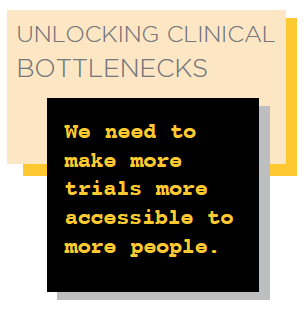Unlocking clinical Bottlenecks
We need to make more trials more accessible to more people. participate
 Bert Hartog, Ph.D., senior director at Janssen Clinical Innovation, Janssen Research & Development LLC is driven to eliminate the challenges preventing patients from participating in clinical trials.
Bert Hartog, Ph.D., senior director at Janssen Clinical Innovation, Janssen Research & Development LLC is driven to eliminate the challenges preventing patients from participating in clinical trials.
“The number of people who know about trials is in the 5% to 10% range," he says. “The number of people participating in trials is even lower, yet all these trials are important. Patients are waiting for solutions that we can’t investigate fast enough."
One of the key barriers, according to Dr. Hartog, is related to patient recruitment. He believes technology is one of the ways in which to make clinical trials more accessible to a diverse populations across multiple geographies.
“To make trials more accessible, we are focusing on what patients need and expect," he says. To understand their needs, Dr. Hartog and his team have spent a great deal of time gathering insights through a number of breakthrough initiatives. “First, we needed to demystify the perception that pharmaceutical companies couldn’t connect with patients," he says.
Then Dr. Hartog and his team utilized a range of methods to invite patients to share their insights through question-and-answer surveys, focus groups, and clinical trial simulations, in which they recreate the essence of a new trial into a four-hour workshop. Using this approach, in a relatively small amount of time, they are able to collect the best feedback to optimize the design and implementation of a trial that otherwise they could only learn from running the trial.
Another exciting area Dr. Hartog and the team is exploring is digital health solutions, including voice technologies, AI chat bots, etc. He believes that by embedding these technologies into a scientific portfolio of tools or methods for capturing the various measurements inherent in clinical  trials, it would allow people to stay at home and feel good about having access to trials as an alternative to standard of care.
trials, it would allow people to stay at home and feel good about having access to trials as an alternative to standard of care.
“A virtual trial setup or a direct-to-participant trial setup allows people to participate in research who can’t spend as much time in the clinic for a traditional trial because they live too far away, or because of employment, or family obligations," he says. “If we can move appropriate approaches from the clinic into a home setting we can potentially reduce some hurdles and allow more people, specifically those deeper into the communities, to participate in clinical research, which can accelerate trials and allow new science to become available to people who need it."(PV)










